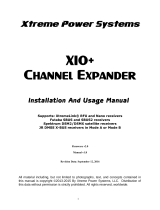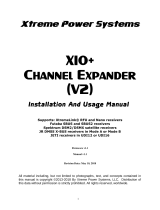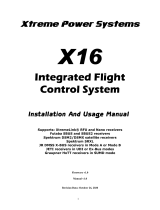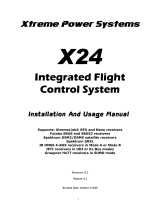Page is loading ...

1
Xtreme Power Systems
XtremeLink
®
Installation And Usage Manual
XtremeLink
®
is a registered trademark of Xtreme Power Systems, LLC.
Firmware v3.0-v3.8
Manual v2.5
Revision Data: January 11, 2011
All material including, but not limited to photographs, text, and concepts contained in
this manual is copyright ©2006-2011 By Xtreme Power Systems. Distribution of this
data without permission is strictly prohibited. All rights reserved, worldwide.
DUE TO FREQUENT CHANGES IN THIS MANUAL, PLEASE DO NOT POST,
UPLOAD, OR OTHERWISE PROVIDE THIS INFORMATION VIA ANY MEANS!

2
Introduction
Thank you for purchasing the XtremeLink
®
system. This system is a direct
replacement for your stock RF module and receiver.
Please read through this entire manual before you attempt the installation
and usage of your XtremeLink
®
system!
Installation Requirements
The installation of the XtremeLink
®
RF module is not difficult. However, if
after reading through this manual you believe that you cannot perform the
installation, please seek someone who can assist you.
This manual should provide ample information and clarity to install and use
this product.
Warranty Information
The XtremeLink
®
system carries a limited lifetime warranty. Units subject to
improper installation, misuse, abuse, or modifications will not be covered
under this warranty.
Xtreme Power Systems may at its discretion either repair or replace the unit
covered under warranty. The customer will pay all freight charges to and
from Xtreme Power Systems. Xtreme Power Systems must be contacted to
obtain a return authorization. Any product returned without authorization
will be returned without repair or replacement.
Liability
By using this product, you agree to hold Xtreme Power Systems free from
any type of liability either directly or indirectly while using this product.
Legal Information
The ‘look and feel’ and functionality of this product are protected by U.S.
copyright laws. Various terminology and feature names are protected under
U.S. trademark laws.

3
- NOTICE -
THIS SYSTEM REQUIRES PROPER
POWER!
PLEASE READ SECTION 5 FOR
INFORMATION ON THE
RECOMMENDED POWER SETUP
AND HOW TO IDENTIFY IF YOU
ARE HAVING A POWER PROBLEM.

4
SECTION 1 – INSTALLATION
Step 1 – Removing the stock RF module
Futaba, JR, and Hitec RF modules have tabs either on each side or top and
bottom. Carefully squeeze these tabs and pull the RF module from the
transmitter. Sometimes each side or each end will need to be wiggled for
the module to come loose and removed. See Figures 1 and 2 for reference.
Figure 1 – Futaba RF module removal

5
Figure 2 – JR RF module removal

6
Step 2 – Installing the XtremeLink
®
RF Module
Position the XtremeLink
®
RF module over the original RF module location,
and slowly press the module into the transmitter case. There should be no
excessive force required to install the module. When the module is properly
installed, it will “snap” into place and sit flush with the back of the
transmitter case.
See figures 3 and 4 for reference.
Locate the included removable antenna and screw it into the connector on
the back of the XtremeLink
®
RF module. Finger tighten only!
The stock metal transmitter antenna MUST be removed. Nearly all
transmitter antennas simply unscrew. If your transmitter has a pivot ball on
top that the antenna normally screws into, do not screw in the antenna
when the XtremeLink
®
RF module is installed.
If you switch back to a stock RF module, remember to re-install the
antenna or damage may result to the transmitter!
When using the XtremeLink
®
RF module, the transmitter’s modulation output
must be set to PPM, MPLX, PPM18, or PPM24. PCM, APCM, SPCM, PCM1024,
PCM2048, or any other method of modulation is not currently supported.
This may change in the future. You will know if the modulation output is
correct or not by looking at the STATUS LED when the power is turned on.
If the STATUS LED lights up orange and does not change, the transmitter
modulation is not set correctly. If the STATUS LED flashes red, then the
transmitter modulation is set correctly.

7
Figure 3 – Futaba XtremeLink
®
module installation

8
Figure 4 – JR XtremeLink
®
module installation

9
Step 3 – Mounting the receiver
No matter which XtremeLink
®
receiver you use, the mounting procedure is
the same. The most important thing to remember is that you must keep the
antenna portion of receiver no less than 2 inches from any type of large
metal or wiring that is not directly coming out of the receiver. This includes
steel, carbon fiber, servos, fuel pumps, any type of wiring, etc. The best
method of mounting is to show it off! Mount the receiver as high and out in
the open as possible so you can easily see it and get access to it (see
Figures 5 & 6 for examples). Under no circumstance can you wrap or pass
servo wires around the antenna! Remember that wires can move under
g-force, so make sure that wires can not move at all around the
receiver. Moving wires can cause intermittent radio control. See
figures 5 and 6 for reference.
We have found the best receiver orientation to be with the antenna pointing
upwards, which gives the best results when making approaches from far
away.
Figure 5 – XtremeLink
®
8 channel receiver installation

10
Figure 6 – XtremeLink
®
10 channel receiver installation in a
Composite ARF Flash jet.
The servo connection slots on the XtremeLink
®
receivers are numbered.
There is a slot that is labeled “B/T”. This is for a battery connection, and can
also be used for the telemetry sensor data port. Do not plug the power
into this port backwards! The receiver will power up and appear to work,
but it will not function properly powered this way!
Power and ground are available on every numbered slot. “Signal” is the pin
nearest the number. The function for each channel is determined by the
transmitter in use, and not the receiver itself. For example, throttle control
with most JR radios is on channel 1, while throttle control on most Futaba
radios is on channel 3. Throttle output would be determined by the radio
and will change with brands. Keep this mind when setting up a different
transmitter.

11
SECTION 2 – TRANSMITTER MODULE
After turning on your transmitter, the STATUS LED on the XtremeLink
®
RF
module will light orange briefly followed by either flashing red, if using
Hopping mode 1, or rapidly flashing red if using any of the other hopping
modes. Red indicates there is no connection with an XtremeLink
®
receiver.
When a connection is established, the STATUS LED will light solid green if
using Hopping mode 1, or rapidly flashing green if using any of the other
hopping modes.
Advanced Programming Features
Advanced programming mode allows various features to be changed.
NOTE - Any XtremeLink
®
receiver that has been “bound” to the XtremeLink
®
RF module must be turned off prior to powering on the transmitter.
To enter advanced programming mode, press and hold the PROG button and
then turn on the power to the transmitter. Hold the button until the STATUS
LED changes from off, to green, and then finally to red. This process will
take approximately 7 seconds.
Once you are in programming mode, each time you press and release the
PROG button, the STATUS LED color will change. Below is a table of STATUS
LED colors and their meanings:
STATUS LED
FUNCTION
Solid Red Set Power Level
Solid Green Set Hopping Mode
If you press and hold the PROG button while the STATUS LED is any one of
these colors, you will enter the programming for that function.
Additional features will be added in the future.

12
SET POWER LEVEL
Range: 1 to 5
With the STATUS LED solid red, press and hold the PROG button until the
STATUS LED turns off. The STATUS LED will now slowly flash green the
number of times equal to the current power setting. For example, the
default power level is 5, so the STATUS LED will flash green five times.
After the flashing stops you have five seconds to change the power level. To
change the power level, press and release the PROG button one time for
each level of power you would like. For example, if you wanted the power
level to be the lowest possible value, you would press and release the PROG
button just once. If you wanted the power level to be 3, you would press
and release the button three times.
If you do not press the PROG button within five seconds, or if the value you
enter exceeds what is allowed, the STATUS LED will alternately flash red and
green (error condition occurred) and no change will be made. At this point,
you are back at the programming mode start (where you can select a
programming option).
If you do make a change, the STATUS LED will blink green/red/orange in
rapid succession to let you know that the change was successful.
Below is a table of required power levels for various countries.
Country Allowable setting
North America
1-5
Australia & U.K.
1-5
Japan & France
1-2 Hop Mode 1, otherwise 1-5
Europe
1-2 Hop Mode 1, otherwise 1-5

13
SET HOPPING MODE
Range: 1 to 5
With the STATUS LED solid green, press and hold the PROG button until the
STATUS LED turns off. The STATUS LED will now slowly flash green the
number of times equal to the current hopping mode setting. For example, if
hopping mode is currently set to 3, the STATUS LED will flash green three
times.
After the flashing stops you have five seconds to change the hopping mode.
To change the hopping mode, press and release the PROG button as many
times as necessary to equal the hopping mode you would like. For example,
if you wanted the hopping mode to be 3, you would press and release the
button three times.
If you do not press the PROG button within five seconds, or if the value you
enter exceeds what is allowed, the STATUS LED will alternately flash red and
green (error condition occurred) and no change will be made. At this point,
you are back at the programming mode start (where you can select a
programming option).
If you do make a change, the STATUS LED will blink green/red/orange in
rapid succession to let you know that the change was successful.
Below is a table of available hopping modes.
Hopping Mode Setting
Single frequency w/predictive 1
FCC Full Time 2
FCC Full Time w/adaptive 3
ETSI Full Time 4
ETSI Full Time w/adaptive 5
The difference between the FCC and ETSI hopping schemes is the number of
frequencies used. Until this product is re-certified to use more frequencies
(like what has already been done with ETSI testing in Europe), the
frequencies for the U.S. and other FCC compliant countries are same as the
Single frequency w/predictive hopping mode. ETSI hopping increases the
number of frequencies used in hopping sequence.
Note: adaptive mode is still in development and subject to change.

14
SECTION 3 – RECEIVER
After powering on your XtremeLink
®
receiver, the STATUS LED will light solid
red for up to 3 seconds and then begin flashing red. Flashing red means
that there is no connection to an XtremeLink
®
transmitter module.
When a connection is established, the STATUS LED will light solid green.
Advanced Programming Features
Advanced programming mode allows various features to be changed.
NOTE - Any transmitter with an XtremeLink
®
RF module that has been
“bound” to the XtremeLink
®
receiver must be turned off prior to powering on
the receiver. Power up your XtremeLink
®
receiver and wait for the STATUS
LED to begin flashing red.
To enter advanced programming mode, press and hold the programming
button on the XtremeLink
®
receiver until the STATUS LED changes from off
to green, and then finally red. This process will take approximately 7
seconds.
NOTE - The receiver’s programming button is located on the circuit board
itself and can be depressed using our radio tool (available from our online
store) or by using a 3/32 Allen key or similar BLUNT object. DO NOT USE
ANY TYPE OF SCREWDRIVER to press the button or damage will result! See
Figure 7 for whole location.
Once you have entered programming mode, the STATUS LED will be solid
red (the first programming option). Each time you press and release the
programming button, the STATUS LED will change colors, indicating a
different programming function. Below is a table of STATUS LED colors and
their meanings, followed by a detailed description of each programming
option.

15
STATUS LED
FUNCTION
Solid Red 1 - Set Channel Map
Solid Green 2 - Set Country
Solid Orange 3 - Not Used
Blinking Red 4 - Set Failsafe Map
Blinking Green 5 - Set Failsafe Time
Blinking Orange 6 - Telemetry Setup
Figure 7 – XtremeLink
®
receiver programming button location

16
FUNCTION 1 - SET CHANNEL MAPPING
Range: 1 to number of receiver channels
Channel mapping is a handy feature when you have a transmitter with
limited functionality or you just want assign channels to different output
pins. The default channel map is 1:1. This means that the transmitter’s
channel 1 is mapped to the XtremeLink
®
receiver’s output channel 1. One
common use for this feature is assigning two throttle outputs. Instead of
using a “Y-cable” to tie the servo outputs together, you can just assign a
second output. You could use the normal throttle channel output (channel 1
for most JR), and assign it also to be a channel 10 output (providing you had
a 10 channel XtremeLink
®
receiver). The outputs occur at the exact same
time, completely eliminating any type of “lag” that is common when using
individual channels for duplicating outputs.
With the STATUS LED solid red, press and hold the programming button until
the STATUS LED turns off. The STATUS LED will now flash orange the
number of times equal to the current receiver servo output position, followed
by a one second pause. When you first enter the channel map programming
(output 1), the STATUS LED will flash once, followed by a one second pause.
Every time you press and release the programming button, the channel map
position will advance by one. The channel map position begins at output 1
(one flash) and ends with the number of channels that your receiver has.
So, the 8 channel XtremeLink
®
has eight possible channel map positions,
while the 10 channel XtremeLink
®
receiver has ten possible channel map
positions.
To change the channel map output, press and hold the programming button
until the STATUS LED turns off, and begins flashing green. The STATUS LED
will begin flashing green the number of times equal to the current
transmitter channel number for that servo output position. For example, the
default value of the channel map 1 would flash just once, indicating the
throttle channel (for JR radios). After the STATUS LED is done flashing
green, you have five seconds to enter a new channel number value. You do
this by pressing and releasing the programming button the number of times
equal to the new channel number. NOTE - It is possible to set the channel
number to be any value from 1 to 16. This allows you to assign a channel
number higher than what you receiver normally has for outputs. An
example of this would be using a 6 channel XtremeLink
®
receiver with
channel 7 assigned to servo output position 5 (which might be a proportional
control for a variable pitch propeller).

17
If you do not press the programming button within five seconds, or if the
value you enter exceeds what is allowed, the STATUS LED will alternately
flash red and green (error condition occurred) and no change will be made.
At this point, you are back at the channel map position where you can
advance to the next channel. There is no way to get back to the
programming mode start with this feature other than by powering off the
receiver and re-entering the advanced programming mode.
If you do make a change, the STATUS LED will blink green/red/orange in
rapid succession to let you know that the change was successful.
FUNCTION 2 - SET COUNTRY
Range: 1 to 4
With the STATUS LED solid green, press and hold the programming button
until the STATUS LED turns off. The LED STATUS will now slowly flash green
the number of times equal to the current country setting. For example, the
default country level is 1, so the STATUS LED will flash just once.
After the flashing stops you have five seconds to change the country. To
change the country, press and release the programming button the number
of times necessary to equal the country from the list below. For example, if
you wanted to set the country to France, you would press and release the
programming button two times.
If you do not press the programming button within five seconds, or if the
value you enter exceeds what is allowed, the STATUS LED will alternately
flash red and green (error condition occurred) and no change will be made.
At this point, you are back at the programming mode start where you can
select another programming option.
If you do make a change, the STATUS LED will blink green/red/orange in
rapid succession to let you know that the change was successful.
The country selection is necessary to meet various FCC, ETSI, IC, and other
guidelines.
NOTE: This setting only applies to Hopping Mode 1, and is ignored for all
other hopping modes.

18
Below is a table of allowable settings:
Country Setting
All Countries except France
1
France
2
FUNCTION 3 - SET OUTPUT MODE
Range: N/A
This function is not currently supported. The STATUS LED will be solid
orange. It will be supported in future versions for a new function.
FUNCTION 4 - SET FAILSAFE MAP
Range: 1 to number of receiver channels
It is possible to set the failsafe control for each channel output individually.
You can set each channel to either hold last position, or to use the user
defined position (discussed in section 4). NOTE - The default for ALL outputs
is hold last position.
With the STATUS LED blinking red, press and hold the programming button
until the STATUS LED turns off. The STATUS LED will now flash orange the
number of times equal to the current channel output, followed by a one
second pause. When you first enter the failsafe map programming (channel
1), the STATUS LED will flash once, followed by a one second pause.

19
Every time you press and release the programming button, the channel
position will advance by one. The failsafe map position begins at channel 1
(one flash) and ends with the number of channels that your receiver has.
So, the 8 channel XtremeLink
®
has eight possible channel output positions,
while the 10 channel XtremeLink
®
receiver has ten possible channel output
positions.
To change the failsafe control for that channel output, press and hold the
programming button until the STATUS LED turns off and begins to flash
green. The STATUS LED will flash either one time (failsafe hold) or flash two
times (failsafe is user defined). After the STATUS LED is done flashing green,
you have five seconds to enter a new failsafe control value. You do this by
pressing and releasing the programming button either one time for hold
last position or two times for user defined position.
If you do not press the programming button within five seconds, or if the
value you enter exceeds what is allowed, the STATUS LED will alternately
flash red and green (error condition occurred) and no change will be made.
At this point, you are back at the failsafe map position where you can
advance to the next channel. There is no way to get back to the
programming mode start with this feature other than by powering off the
receiver and re-entering the advanced programming mode.
If you do make a change, the STATUS LED will blink green/red/orange in
rapid succession to let you know that the change was successful.
If you wanted a low throttle condition and all other outputs to hold their last
position with a JR radio setup, you would set the failsafe map so that
channel 1 was two flashes (failsafe is user defined), and all other outputs to
one flash (hold position). You would then need to set the failsafe as
described in section 4 to obtain your low throttle position.
FUNCTION 5 - SET FAILSAFE TIME
Range: 1 to 5 seconds
A failsafe condition occurs when data received by the XtremeLink
®
receiver is
not valid for some period of time. This time can be set from one to five
seconds.

20
With the STATUS LED flashing green, press and hold the programming
button until the STATUS LED turns off. The STATUS LED will now slowly
flash green the number of times equal to the current failsafe time (in
seconds). For example, if the failsafe time is set to two, so the LED will flash
two times, indicating a failsafe period of two seconds.
After the flashing stops you have five seconds to change the failsafe time.
To change the failsafe time, press and release the programming button one
time for each additional second you would like the failsafe time to be. For
example, if you wanted the failsafe time to be 1 second, you would press
and release the programming button once. If you wanted the failsafe time
to be 3 seconds, you would press and release the button 3 times.
If you do not press the programming button within 5 seconds, or if the value
you enter exceeds what is allowed, the LED will alternately flash red and
green (error condition occurred) and no change will be made. At this point,
you are back at the programming mode start.
If you do make a change, the LED will blink green/red/orange in rapid
succession to let you know that the change was successful.
FUNCTION 6 – TELEMETRY SETUP
With the STATUS LED flashing orange, press and hold the programming
button until the STATUS LED turns off and then release the button. Press
the button on each telemetry device in the order of importance (satellite
receivers should be first). Telemetry must be enabled using the XDP
software for any sensors that are connected, with the exception of satellite
receivers which do not require the telemetry system to be enabled.
XDP (COMPUTER) INTERFACE
To put the receiver into computer programming mode, press and hold the
programming button and then apply power to the receiver. The STATUS LED
will be solid orange, indicating it is ready for computer programming.
/








